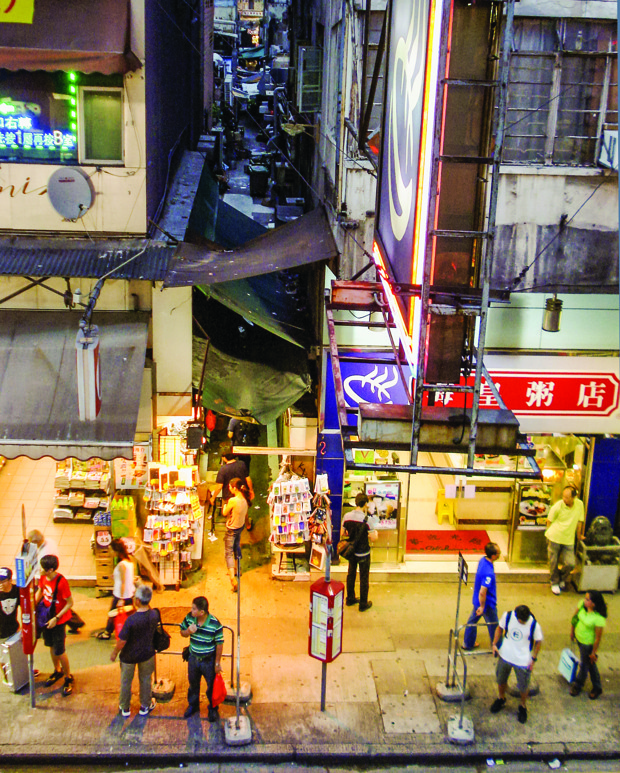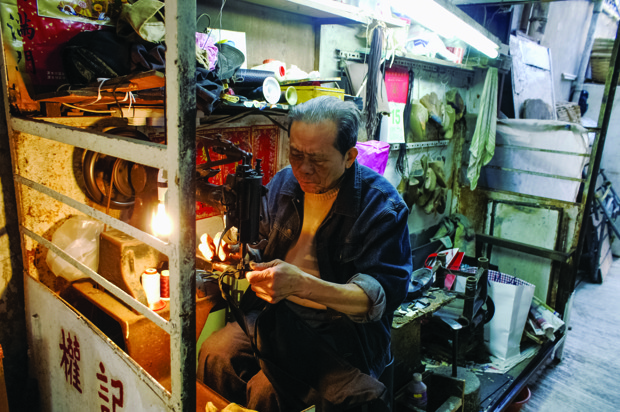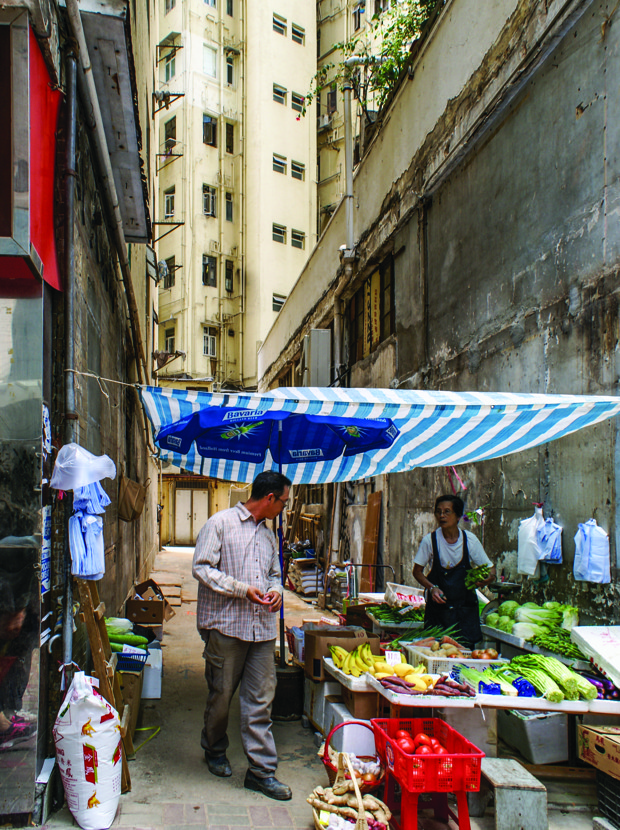
An alleyway in Tsim Sha Tsui is illuminated by the pink glow of a small fish store. (Parallel Lab)
Hong Kong today is known for its magnificent skyline, set against the backdrop of the region’s gleaming harbors and lush hills. It’s known for its efficient network of high-tech railways and old-timey streetcars—and for being one of the densest cities on earth.
But that’s not all that defines Hong Kong. If you want to understand how the city has evolved, look beyond its sleek high-rises and modern skyscrapers. Instead, follow its vast network of “in-between” spaces, says Caroline Wuthrich, a Swiss architect and designer based in Hong Kong.
These are the city’s back lanes and alleyways—narrow veins that snake between tightly packed buildings and retain the rawness of Hong Kong. Turn a corner, and you’ll be greeted by “a sense of remoteness in the heart of the city,” Wuthrich and her colleague Geraldine Borio—both founders of the urban research firm Parallel Lab—write in their 2015 book Hong Kong In-Between.
The honking of taxis and the rumbling of buses fade as you go deeper into the city’s alleys. Eventually, they’re drowned out by the humming of air conditioners in the windows of buildings towering above. “We are but moments from the city’s loud multi-lane roads, yet seemingly miles away,” they write.

In some alleys, you might find only a dingy tunnel with a canopy of dripping pipes. Some are filled with clever storage hacks. But in others, you can find a microeconomy of small, simple businesses—a fabric shop carved into a space barely big enough to fit its vendor, a vegetable stand with boxes and bins lining the walls, a vintage barbershop with just enough seats for one or two patrons.
Some of these alleyway shops have been in operation for 40 years or more, passed down through generations, as the Hong Kong government no longer issues street-vending licenses. Those vintage barbershop chairs are still in use from the ‘60s and ‘70s, says Wuthrich, and the same customers have been coming for decades.
“In a consumerist city, suddenly it's not just about consumption,” she tells CityLab. “Even the shaver would be from the 1970s, and it's quite amazing how time somehow stands still in these little businesses.”

According to Wuthrich and Borio’s book, the network of narrow back lanes reflects how the city was planned between the late 1800s and the 1950s. Developers tended to divide livable land into rows of long, narrow plots spanning about 100 feet in length and just 10 to 13 feet in width. Buildings were built back-to-back. As the economy thrived and the population grew between the 1950s and the 1980s, developers built pencil-thin towers in an effort to squeeze as many living units as they could onto these small plots of land.
The alleys existed primarily as service lanes, for necessary things like waste disposal. “They were purely pragmatic, and nobody was really interested because they were just sort of these dirty places,” says Wuthrich. Over time, however, locals made the unregulated alleys their own. Restaurant seating areas extended into alleyways, housed under tarps. Dishes would be washed outside in the same space where employees took their lunch breaks. And lower-end retailers occupied the spaces as a way to escape Hong Kong’s skyrocketing rents.
“It became this back side of the city,” Wuthrich says. “And today it is really a parallel universe.”

There’s an allure to these places, Wuthrich says. There’s always something to draw you in, whether it’s the faint pink glow surrounding a fish store or the colorful stripes of a barbershop pole. Still, in the eyes of locals, alleys are often seen as eyesores and as a place for gang or criminal activity. So in 2012, Wuthrich and Borio tried to get locals to rethink the use of these spaces in a project called STAG. They hosted pop-up events in Hong Kong alleyways, creating a makeshift theater and bringing in local craftsmen who owned alley shops to showcase their skills.
There’s a case to be made for revitalizing alleyways, to clean them up and transform them into community hot spots. In fact, the government has introduced such initiatives. But Wuthrich argues that these informal spaces are best left in the hands of the few locals who have found use in them.
“These are the last spaces in Hong Kong that are not fully controlled, and if you take them away, a whole layer of microeconomics falls out,” she says. “It would just end up with fancy shops opening there. But left to the people, these back lanes can be converted by each single user into something they want it to be.”

http://www.citylab.com/housing/2016/07/the-roots-of-hong-kongs-identity-are-in-its-back-alleys/491258/